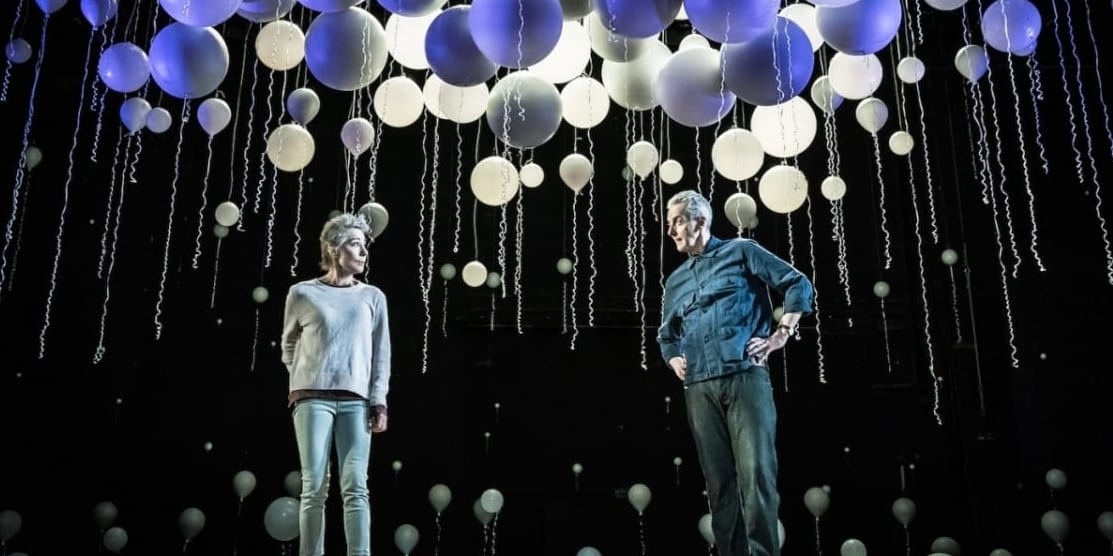While the Donmar Theatre is closed for refurbishment, artist director Michael Longhurst continues productions elsewhere, and in this case a revival of Nick Payne’s 2012 hit ‘Constellations’, a breakthrough moment in both their careers. But it is a revival with a difference: instead of a single cast for this two-hander there are four, reflecting the fact that couples of different ages, ethnicities, and sexualities could take the script in various directions. This is also in line with the intellectual context for the play which suggests as a result of recent developments in quantum mechanics that we live in a ‘multiverse’ in which several outcomes are both possible and parallel simultaneously.
This review is of the performance by Capaldi and Wanamaker, representing the oldest of the
four couples; but the hope is that audiences may wish to encounter more than one version.
The plot-line can be briefly summarised because it is the least important part of the play.
Marianne, a quantum cosmologist and Roland, a beekeeper, meet at a barbecue hosted by
mutual friends and appear to get on well – or not. In the opening scenes the same
sequences are played out in slightly different iterations suggesting highly contrasted
outcomes. They may go home together or go their separate ways; they may or may not
settle down together, break up, resume contact, and finally have to face a health crisis that
leads inexorably to a date with Dignitas. It is as though the play is left as a manuscript of
various drafts all interleaved and played out alongside each other, with some time
disruptions added for good measure.
While this might seem at first sight repetitive and frustrating in fact it works out well on
several levels of dramatic engagement. First of a it is actually a very humorous play about
relationships – you totally believe in the twists and turns of this couple’s connections even
as those connections are unravelled as soon as they are made. But going beyond that there
are depths of insight available on big themes such as free will and determinism, euthanasia,
and recent theoretical physics. The beauty of it is that you can dive down into those depths
if you want to do so, or simply stay on the glittering, brittle, and uncertain surface of the
relationship itself.
There is great opportunity for actorly invention here which Wanamaker and Capaldi grasp
eagerly. Like musicians playing a set of variations they take the sequences of near-repeated
scenes and find a sophisticated range of nuances and inflections and gestures to ensure
each repetition has a different character. It is almost as though each of them is improvising their way through a final satisfactory version just as we all consider various possible outcomes in human interactions before plumping for one over the others. Each of them plays the game of ‘sliding doors’ with expert skill gradually reeling the audience into the
poignancy of choices or their absence.
The creative team for the production is the same as in 2012, and indeed there seems no
need to change such a winning combination. A warm honeycomb-patterned parquet floor
dominates the stage, fringed around and above by a host of white balloons on curly
streamers. This is presumably partly a reference to the beehives and atomic and sub-atomic
physics that are embedded in the text; but also pointing more generally to the slippery
moods of the play, both celebrating the joys of life, while also recognising their fragility and
evanescence. There are no props or furniture to distract from the debate. Given the
complexity of the time shifts in the play more interpretive weight therefore moves to the
mood shifts provided by Lee Curran’s complex lighting scheme, which follows and sets the
emotional temperature with great sensitivity and warmth.
Since theatre began to open up again in the last month many observers have made rather
heavy weather of the need to provide commentary on the pandemic and its consequences.
Such commentary is most likely to succeed when oblique and dramatically grounded rather
than through externalised sermonising; and this play’s subtle reflections on and refractions
of the fragility of relationships and the real limitations on human choice provide exactly that
kind of timely pause for thought.

